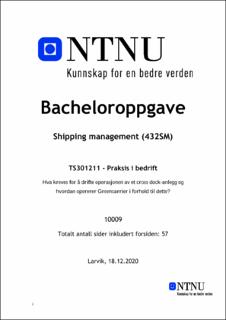| dc.contributor.advisor | Danielsen, Antoni Vike | |
| dc.contributor.author | Røed, William | |
| dc.date.accessioned | 2021-09-24T19:18:06Z | |
| dc.date.available | 2021-09-24T19:18:06Z | |
| dc.date.issued | 2020 | |
| dc.identifier | no.ntnu:inspera:72403850:72405309 | |
| dc.identifier.uri | https://hdl.handle.net/11250/2782190 | |
| dc.description.abstract | Dagens marked er preget av sterk konkurranse, hvor leverandører og produsenter er under et konstant press for å få levert produktet sitt raskest mulig samtidig som kostandene holdes nede. Målet til de fleste forsyningskjeder er å få varene til å nå destinasjonen sin på kortest mulig tid med minimale kostander. Cross docking er en logistikkløsning som kan hjelpe med å øke effektiviteten, samt å holde kostnader lave om det bli anvendt korrekt og under de rette forholdene.
I denne oppgaven er problemstillingen «hva kreves for å drifte operasjonen av et cross dock-anlegg og hvordan operer Greencarrier i forhold til dette?». Det blir beskrevet hva cross docking er og hvordan det fungerer, samt at de forskjellige typene cross dock blir gjort rede for. Gjennom teorien til John Vogt om ni suksesskriterier for cross dock og andre forskere sine synspunkter, blir det beskrevet hva som kreves for å kunne drifte en cross dock-operasjon.
Gjennom deltakende observasjon og intervjuer blir det gjort rede for hvordan Greencarrier sitt anlegg opererer i forhold til disse kriteriene, samt hvordan disse kriteriene påvirker operasjonen. Det blir drøftet hva som kreves av blant annet forsyningskjeden, arbeiderne og ledelsen for at operasjonen av anlegget skal være mest mulig effektivt.
Det blir avdekket utfordringer Greencarrier møter på i driften sin som skaper ineffektivitet. Dette er utfordringer som er knyttet til blant annet at de håndterer sesongbasert produkter, uforutsigbare leveranser og designet på anlegget deres. Det kommer også frem fordeler Greencarrier har som hjelper dem med å optimalisere driften deres; Som for eksempel at de selv håndterer transporten til store deler av varene de mottar, og at de har en form på vareflyten hvor de enkelt får fordelt personal og ressurser ved ulike prosesser i anlegget | |
| dc.description.abstract | Today’s market is characterized by strong competition, where suppliers and manufacturers are under a constant pressure to have their product delivered as quickly as possible while keeping costs down. The goal of most supply chains is to get the goods to reach their destination in the shortest possible time with minimal costs. Cross docking is a logistics solution that can help increase efficiency, as well as keeping costs low if applied correctly and in the right conditions.
In this thesis, the research problem is “what is required to operate the operation of a cross dock-facility and how does Greencarrier operate compared to this?” It is described what cross docking is and how it works, as well as the various types of cross docks are explained. Through John Vogt’s theory of nine succescriterias for a cross dock and other articles views it is described what is required to operate a cross dock operation.
Through participatory observation and interviews, it is made clear how Greencarrier’s facility operates compared to these criteria. As well as how these criteria affect the operation. It is discussed what is required of, among others, the supply chain, the workers, and the management for the operation of the facility to be as efficient as possible.
There are revealed challenges Greencarrier face in the operations that creates inefficiency. These are challenges related to, amongst other things, that they handle seasonal products, unpredictable deliveries, and the design of their facility. There are also found advantages that helps Greencarrier optimize their operations, such as that it is themselves who handle the transport of large parts of the goods they receive, and they have a form of goods flow where they easily can share personnel and resources within the processes in the facility. | |
| dc.language | nob | |
| dc.publisher | NTNU | |
| dc.title | Krav for å drifte operasjonen av et cross dock-anlegg | |
| dc.type | Bachelor thesis | |
